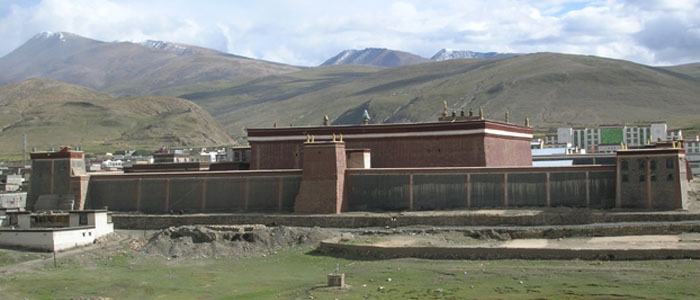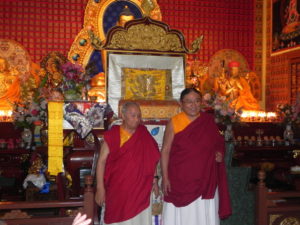Preserving the Sakya Tibetan Buddhist Heritage for future generations
Sakya History


In 1042, Atisha, the great Indian Buddhist master who helped revive Buddhism in Tibet, was traveling in Tibet spreading the Buddha’s teachings. At the side of a mountain where there was “pale earth,” he foresaw the emanations of three bodhisattvas whom he knew would spread the Buddhist doctrine in Tibet: Avalokiteshvara (the embodiment of compassion), Manjushri (the embodiment of infinite wisdom), and Vajrapani (the embodiment of infinite power).
It was at the same site of pale earth some thirty years later, in 1073, that Khön Gönchok Gyalpo (1034-1102), ancestor of Dagchen Rinpoche, built the first Sakya Monastery. The monastery took its name from the pale earth (in Tibetan “sa-kya”) where the monastery was founded. Subsequently, the town that arose there, the family of the monastery’s founder (the Khön lineage), and the school of Tibetan Buddhism took the name of the monastery: Sakya.
The Sakya Sect is one of the four major schools of Tibetan Buddhism including Nyingma, Kagyu, and Gelug. It has its origins in the ancient Khön Family of Tibet when one of the family members, Khön Lui Wangpo Sungwa, became a disciple of the great Indian Saint Padmasambhava in the 8th century becoming one of the first seven Tibetan monks. Sakya (Tibetan: sa skya, English: grey, whitish earth), is named after a large area of white earth in the shape of a lion’s face on the side of Ponpori Mountain in South Western Tibet.
In the Manjushri Root Tantra, Buddha had prophesied that a Sakya Monastery would cause his teachings to flourish in the land of Snows. This Monastery was also prophesied by Guru Rinpoche Padmasambhava who also wrote, “An emanation of the Indian Virupa-Drogmi Lotsawa will appear”. In CE 1040, the Pandit Atisha Dipamkara traveling from India, stopped and performed prostrations after seeing on the mountainside a syllable “Hrih”, seven “Dhih”, and one “Hung”, and prophesied that manifestations of Avalokiteshvara, seven of Manjushri, an one of Vajrapani would divine great blessings on this site.
The Sakya Tradition was established with the first Temple built by Khön Konchog Gyalpo named the Gorum Zimchi Karpo in CE 1073. In the twelfth and thirteenth centuries, the Sakya Tradition rose to a position of prominence in the religious and political life of Tibet, primarily due to the endeavors of the Five Great Sakya Masters (Tibetan: rJe.tzun. gong.ma Inga). Sachen Kunga Nyingpo (1092-1158), Lobpön Sonam Tsemo (1142-1182), Jetsun Dakpa Gyaltsen (1174-1216), Sakya Pandita (1182-1251), Chögyal Phakpa (1235-1280). In CE 1207, Mongol armies invaded and occupied Tibet. In CE 1244, Godan Khan, intrigued by Sakya Pandita’s reputation, invited him to Mongolia to give Buddhist teaching through which, Godan Khan became a Buddhist, and appointed Sakya Pandita Viceroy of Tibet.
In CE 1253, Chögyal Pagpa, the nephew of Sakya Pandita, became the religious teacher to Godan Khan’s famous successor, Kublai Khan. Chögyal Pagpa gave many profound teachings and invented a new script for the purpose of writing the Mongolian language. Kublai Khan was so impressed by Pagpa’s many performances that he declared Buddhism the state religion of Mongolia and in CE 1260, named Drogon Chögyal Pagpa the Imperial Preceptor thereby becoming the first person in Tibetan history to gain religious and secular authority over the entire country.
The Khön Family descendants are the hereditary heirs to the leadership of Sakya which has alternated each generation between the Phuntsog Phodrang, led by H.H. Dagchen Gongma Rinpoche, and the current 41st Throne Holder of the Drolma Phodrang, H.H. Sakya Trizin. Through their sublime blessings and continual guidance, Long Live the Sakya Tradition and may all sentient beings be released from the wanderings of Samsaric suffering.
The Sakya name is also renowned for having lamas as rulers of Tibet. The Sakya patriarch, Chogyal Pakpa (1235 – 1280) was given temporal authority over Tibet through the patronage of the Mongol rulers of China. Subsequently, the Sakya lamas governed Tibet for over 90 years.
The Sakya School is one of the four great Schools of Tibetan Buddhism. The Sakya masters developed a tradition that emphasized study and meditation in equal measure.